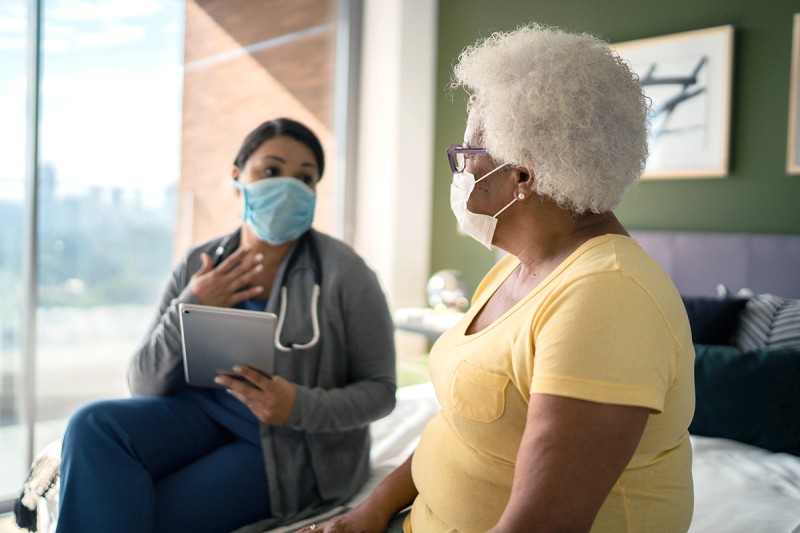
You may have heard about Paxlovid, a treatment for COVID-19, and are wondering if it’s right for you. Paxlovid is intended for people at high risk of developing severe COVID-19 that can lead to hospitalization or death.

Susan Seo is an expert in infectious diseases and is director of the Antibiotic Management Program at MSK. Dr. Seo explains what you need to know about Paxlovid, including effectiveness and potential side effects.
What is Paxlovid? What does it do?
Paxlovid is a drug to treat COVID-19. It is meant for people who have tested positive for COVID-19 and are at risk of experiencing severe symptoms.
Paxlovid was granted Emergency Use Authorization by the U.S. Food and Drug Administration (FDA) in December 2021. This means that the drug is not fully approved, but that the FDA decided it is safe to use based on available data. There are currently no fully approved treatments for COVID-19, though there are other treatments approved under Emergency Use Authorization. More information from the FDA »
Who can take Paxlovid?
Paxlovid can be taken by people who are 12 years or older and weigh at least 88 pounds. Paxlovid is authorized for people who have mild to moderate COVID-19 and are at risk of developing severe symptoms that could lead to hospitalization or death.
This includes (but is not limited to) people who have cancer or have been treated for cancer, and people over age 65.
Paxlovid must be prescribed by a doctor; it is not available as an over-the-counter medication. Before taking Paxlovid, you should talk to your doctor if you:
- have any allergies
- have liver or kidney disease
- are pregnant or plan to become pregnant
- are breastfeeding a child
- have any serious illnesses
When can I take Paxlovid?
You should start taking Paxlovid within 5 days of testing positive.
It’s very similar to Tamiflu, which is a medicine for the flu. Treatment won’t work as well if the virus has been in your body for too long.
How is Paxlovid taken?
Paxlovid is 2 separate medicines. The pills are taken together twice per day for 5 days.
How effective is Paxlovid?
Paxlovid was 89% effective at reducing the risk of hospitalization or death, according to data from the clinical trial that led to the drug’s Emergency Use Authorization. These results were among 1,219 people ages 18 and older who were given Paxlovid within 3 days of experiencing COVID-19 symptoms.
Paxlovid is still being studied, though. The treatment is effective, but we still need to know more.
Do I need to isolate while taking Paxlovid?
Yes. You have an active COVID-19 infection while you are taking Paxlovid.
Read the CDC’s guidance for when to isolate »
What side effects can I expect while taking Paxlovid? What should I do if I experience side effects?
Paxlovid is still being studied, and not all side effects are known. Public health authorities are closely watching for any signs of potential safety problems.
Possible, known side effects are listed below. You should contact your doctor if you experience any of these symptoms while taking Paxlovid.
-
Allergic reactions, which could include:
- Hives
- Trouble swallowing or breathing
- Swelling of the mouth, lips, or face
- Tightness in the throat
- Hoarse voice
- Skin rash
-
Liver problems, which could include:
- Loss of appetite
- Yellowing of your skin and the whites of eyes (called jaundice)
- Dark-colored urine
- Pale-colored stools
- Itchy skin
- Pain in the stomach or abdomen
- Resistance to HIV medicines. If you have HIV that has not been treated, taking Paxlovid could cause some HIV medications to not work as well in the future.
Will I be able to take my regular medication(s) while taking Paxlovid? Are there any drug interactions I should know about?
Unfortunately, there are many medications that Paxlovid may interact with. When discussing Paxlovid with your doctor, you should tell them about all medications you take currently.
Some medications that interact with Paxlovid are:
- apalutamide (Erleada®), a treatment for prostate cancer
- immunosuppressants, which could be used for people who have had an organ transplant
- blood pressure medications
- drugs to lower cholesterol
- drugs to treat heart arrhythmias
- migraine medications
What is a “rebound” after taking Paxlovid? What does it mean?
A “rebound” is when you get COVID-19, take Paxlovid, test negative, and then test positive for COVID-19 again. This new positive test could occur just a couple days after testing negative — or it could be several weeks.
Rebounding means that some of the virus was still circulating in your body. It does not mean that your body is resistant to Paxlovid or that you have a new COVID-19 infection. You may experience some mild COVID-19 symptoms, or you may feel totally fine.
If you rebound, according to CDC guidance, you should isolate again for at least 5 days. You should not take Paxlovid again.
Can I get Paxlovid as an MSK patient?
Yes. If you are a current MSK patient and you have tested positive for COVID-19, please call your primary MSK doctor.
August 15, 2022
